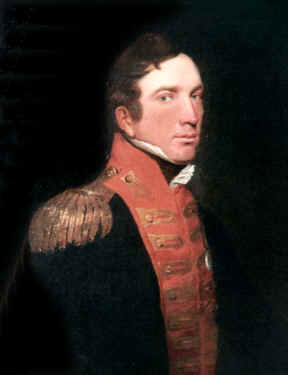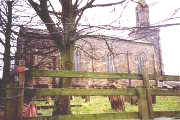Extracts of letters
written to Captain William Siborne by Colonel Samuel Rudyerd to with
his recollections of the Waterloo Campaign
United Services Club,
London,
May 6th, 1838. 16th
June 1815 At
daybreak . . . . I was with two guns attached to the 69th,
Lieutenant Colonel Morice, and placed myself on their right, when
I was directed to follow the four other guns of Major Lloyd's Battery
ordered into action in front of the farm of Quatre Bras, on the Charleroi
road, to the support of the Duke Brunswick. I had hardly quitted the
69th when the Cuirassiers charged from the wood
, and before the 69th
could get into square they were rode over, broken, and sad havoc made
among them, their only colour taken, the other being "in the
Hospital of Invalides at Paris, taken at Bergen-op-Zoom," and
but for a Battalion of British Guards coming up to their support,
and, throwing in one of their destructive fires, compelling the Cuirassiers
to return to the wood, not a man save the Colonel and Adjutant would
have escaped but for this timely aid, as Colonel Morice stated to
me before he fell at Waterloo, having there received four musket ball
wounds.
On my reaching the farm
at Quatre Bras, two of Major Cleeve's guns enfiladed the Charleroi
road, and had literally macadamised it with the carcasses of the Cuirassiers
and their horses, who had made a most desperate charge in great force,
but never returned to it.
At this moment Major
Lloyd's six guns were ordered to the point marked D to support the
Duke of Brunswick troops who were getting severely handled by the
enemy, particularly from two batteries in the wood marked E. Colonel
Kelly, Q.M.G.D., ordered us to take up the position we did this under
heavy fire, and before we unlimbered some three or four horses of
each Gun and wagon were killed, some wheels disabled, and literally
some of our gunners were cut in two, for we were not more than from
four to five hundred yards from the Enemy's Batteries.
We succeeded in silencing
them, and also in obliging a solid mass of French Infantry, marked
F, to retrograde and return to the wood. Finding ourselves now alone
without any support , except a few lancers of the Brunswickers and
the duty executed that we were ordered upon, we limbered up and walked
off towards the Quatre Bras farm and joined our Division. . . . .
. . . . . . .
Having sustained much
damage from the enemy's fire, we were occupied the whole night in
repairing broken axle trees, wheels, &c., and had just finished
in time to move off the field, in view of the whole line of French
Cavalry, when a Cannonade between our Horse Artillery and theirs commenced,
and continued at intervals the whole retirement we made towards our
position at Waterloo. By General Picton's orders, our six guns were
united with those of Major Cleeves and took up a position on the height,
close to the Brussels road, right leading from the wood, and we opened
our fire upon the French Infantry who had followed us up rather too
close, and [were] disposed to continue. The range we had was La Belle
Alliance, or just where the road widens into a quarry or open space
(at that time). There we dealt out or round shot liberally and caused
much destruction, as the head of the Enemy's Columns were unable to
retrograde from the pressure in their rear, and did not extricate
themselves for some time, and must have suffered much. Two batteries
of French Horse Artillery played upon us at the time, but not with
much effect. The shot holes in La Belle Alliance (which you have seen,
perhaps) were perforated at this period. By order of the Duke, we
ceased firing and remained on our ground until morning, when we took
up our position for battle on the 18th in front of Hougomont.
I remain &c.,
S. RUDYERD.
Whitby,
January 6th, 1835. Early
on the morning of the 18th our position was taken up on
the very crest of the slope in front of our division ; the Regiments
were 69th and 33rds in our rear ; the grain, I can't day
whether wheat or barley, it was above our heads, but soon trodden
down. From this position we never moved one instant until the battle
closed ; the Batteries contiguous to ours were Major Sandham's Royal
Artillery on the right, Major Cleeves' King's German Legion [on] our
left. Major [?Sinclair's] Royal Artillery and a Dutch Battery were
in reserve, and came into action late in the day. At seven o'clock,
when the Imperial Guards advanced, out Guns were still in line. The
French advanced in masses of Infantry, upon which we directed our
fire. Never during the Action did we return the heavy fire kept upon
us by their Artillery. Our fire was ever oblique towards the ground
in front of and right of Hougoumont.
When at the close the
British Infantry advanced in line to the charge, it very much resembled
the curvature of the surf upon the shore. You ask me for nay local
remarks as may assist in the accuracy of the Model. My horses, ammunition
waggons, were in rear of our Guns under cover of a little hollow between
us and our Squares of Infantry. The forge cart, artificers' stores,
and such like were in rear of all out of fire. When ammunition was
to be replenished , a Subaltern conducted such waggons as could be
spared. Hey were supplied from the depot in the wood, and returned
without delay. The ground we occupied was much furrowed up by the
recoil of our Guns and the grazing of the shot, and many holes from
the bursting of shells buried in the ground. As horses were killed
or rendered unserviceable, the harness was removed and placed on the
waggons, or elsewhere. Our men's knapsacks were neatly packed on the
front and rear of our limbers and waggons, that they might do their
work more easily. Every Gun, every carriage, spokes carried
from wheels, all were struck in many places.
The Cuirassiers and Cavalry
might have charged through the Battery as often as six or seven times,
driving us into the Squares, under our Guns, waggons, some defending
themselves. In general, a Squadron or two came up the slope in our
immediate front and on their moving off at the appearance of our Cavalry
charging, we took advantage to send destruction after them, and when
advancing on our fire I have seen four or five men and horses piled
upon each other like cards, the men not having ever been displaced
from the saddle, the effect of canister.
The Duke and all his
staff were frequently in our rear under the heaviest fire, also he
Prince of Orange. I saw the fore-legs taken from the horse of one
of his Highness's A.D.C's at the shoulders, and [he] continued rearing
for some time with his very fat rider, dressed in green. My own horse
was shot through by a 9-pounder shot behind the saddle flap, and did
not fall for some time. Some of the Cuirassiers were left, every charge
among our Guns, killed.
Believe me. &c.,
S. RUDYERD |



